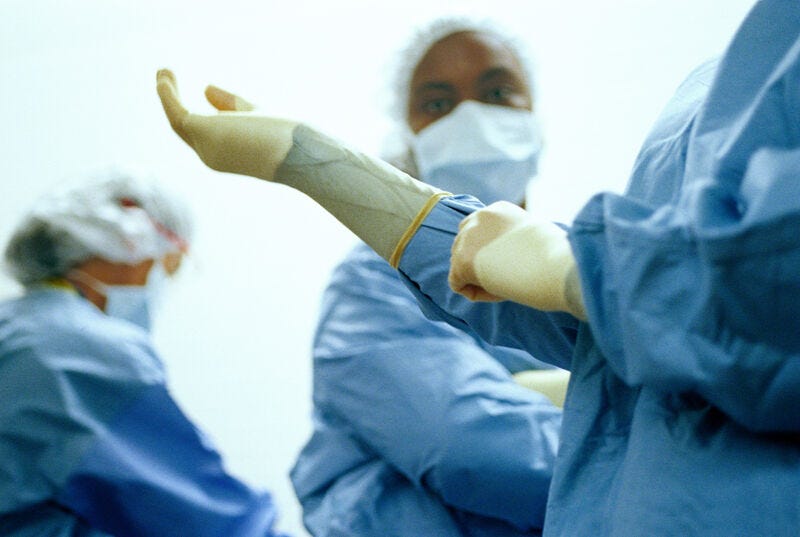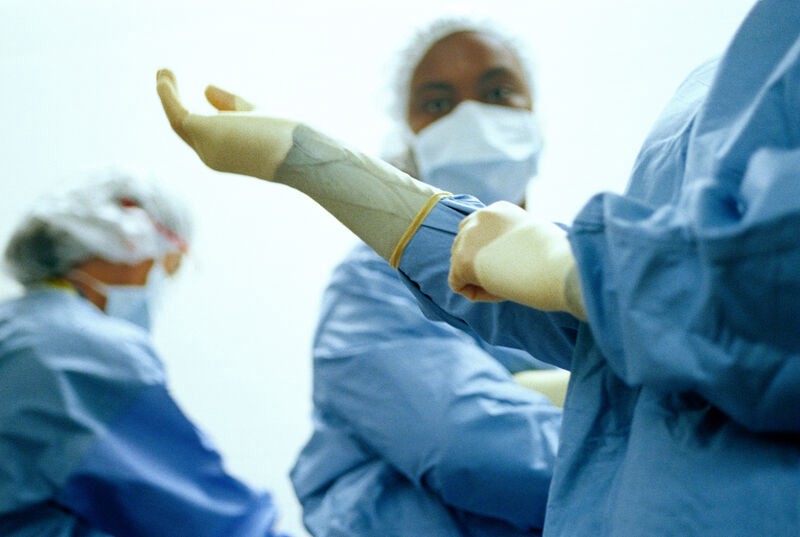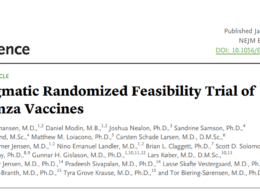Health Transformation Institute (HTI)
Joaquim Cardoso MSc*
Chief Researcher and Editor
November 5, 2022
(* MSc from London Business School — MIT Sloan Programme)
Source: The Lancet
This is a republication of an excerpted version of the paper “Routine sterile glove and instrument change at the time of abdominal wound closure to prevent surgical site infection (ChEETAh): a pragmatic, cluster-randomised trial in seven low-income and middle-income countries”, published in THE LANCET, with the title above.
EXECUTIVE SUMMARY
Background
- Surgical site infection (SSI) remains the most common complication of surgery around the world.
- WHO does not make recommendations for changing gloves and instruments before wound closure owing to a lack of evidence.
- This study aimed to test whether a routine change of gloves and instruments before wound closure reduced abdominal SSI.
Surgical site infection (SSI) remains the most common complication of surgery around the world.
WHO does not make recommendations for changing gloves and instruments before wound closure owing to a lack of evidence.
Methods
- ChEETAh was a multicentre, cluster randomised trial in seven low-income and middle-income countries (Benin, Ghana, India, Mexico, Nigeria, Rwanda, South Africa).
- Any hospitals (clusters) doing abdominal surgery in participating countries were eligible.
- Clusters were randomly assigned to current practice (42) versus intervention (39; routine change of gloves and instruments before wound closure for the whole scrub team).
- Consecutive adults and children undergoing emergency or elective abdominal surgery (excluding caesarean section) for a clean–contaminated, contaminated, or dirty operation within each cluster were identified and included.
- It was not possible to mask the site investigators, nor the outcome assessors, but patients were masked to the treatment allocation.
- The primary outcome was SSI within 30 days after surgery (participant-level), assessed by US Centers for Disease Control and Prevention criteria and on the basis of the intention-to-treat principle.
- The trial has 90% power to detect a minimum reduction in the primary outcome from 16% to 12%, requiring 12 800 participants from at least 64 clusters.
- The trial was registered with ClinicalTrials.gov, NCT03700749.
The trial has 90% power to detect a minimum reduction in the primary outcome from 16% to 12%, requiring 12 800 participants from at least 64 clusters.
Findings
- Between June 24, 2020 and March 31, 2022, 81 clusters were randomly assigned, which included a total of 13 301 consecutive patients (7157 to current practice and 6144 to intervention group).
- Overall, 11 825 (88·9%) of 13 301 patients were adults, 6125 (46·0%) of 13 301 underwent elective surgery, and 8086 (60·8%) of 13 301 underwent surgery that was clean–contaminated or 5215 (39·2%) of 13 301 underwent surgery that was contaminated–dirty.
- Glove and instrument change took place in 58 (0·8%) of 7157 patients in the current practice group and 6044 (98·3%) of 6144 patients in the intervention group.
- The SSI rate was 1280 (18·9%) of 6768 in the current practice group
- … versus 931 (16·0%) of 5789 in the intervention group (adjusted risk ratio: 0·87, 95% CI 0·79–0·95; p=0·0032).
- There was no evidence to suggest heterogeneity of effect across any of the prespecified subgroup analyses.
- We did not anticipate or collect any specific data on serious adverse events.
The SSI rate was 1280 (18·9%) of 6768 in the current practice group … versus 931 (16·0%) of 5789 in the intervention group
Interpretation
- This trial showed a robust benefit to routinely changing gloves and instruments before abdominal wound closure.
- We suggest that it should be widely implemented into surgical practice around the world.
This trial showed a robust benefit to routinely changing gloves and instruments before abdominal wound closure.
We suggest that it should be widely implemented into surgical practice around the world.
Funding
- National Institute for Health Research (NIHR) Clinician Scientist Award, NIHR Global Health Research Unit Grant, Mölnlycke Healthcare.
ORIGINAL PUBLICATION (excerpted version)

Routine sterile glove and instrument change at the time of abdominal wound closure to prevent surgical site infection (ChEETAh):
a pragmatic, cluster-randomised trial in seven low-income and middle-income countries
The Lancet
NIHR Global Research Health Unit on Global Surgery
† Members listed in the appendix.
October 31, 2022
Introduction
Surgical site infection (SSI) is the most common complication of surgery around the world, and disproportionately affects patients in low-income and middle-income countries (LMICs).1
SSI is unpleasant and harmful for patients, increases the care burden on families and communities, and is very costly for patients and providers.2, 3
As a result, SSI was highlighted as the highest research priority in surgery in a global co-prioritisation exercise.4, 5
The causes of SSI are multifactorial, and a so-called magic bullet to prevent SSI is unlikely to exist.
In modern surgical practice, very few interventions to reduce the incidence of SSI have been shown to be effective when tested robustly.1, 6, 7
Clinical guidelines make recommendations for best practice, but the evidence base for included interventions is weak or moderate at best.
WHO (2018),8 the Centers for Disease Control (2017),9 and the National Institute for Clinical Excellence (2019),10 do not recommend routine change of gloves and instruments before wound closure owing to a lack of evidence.
Systematic reviews in 2020 and 2021 identified an urgent need for high quality randomised controlled trials, as only small trials with moderate to high risk of bias were identified.11, 12
In 2017, a group of front-line surgeons from 18 LMICs, prioritised several interventions to reduce SSI on the basis of existing guidelines, community equipoise, cost implications, and feasibility of implementation in low-resource environments.
From this, the group designed a protocol to test routine change of gloves and instruments before abdominal wound closure in 2018.
This intervention was selected as there was early signal of benefit, costs were likely to be low, and it was not practice at the time in collaborating hospitals.
It was considered feasible to implement in resource-constrained settings and, if effective, could be rapidly adopted to improve outcomes and optimise surgical systems.
However, change in behaviour across whole theatre teams requires time and resources; high quality evidence was urgently needed.
This intervention was selected as there was early signal of benefit, costs were likely to be low, and it was not practice at the time in collaborating hospitals.
However, change in behaviour across whole theatre teams requires time and resources; high quality evidence was urgently needed.
ChEETAh aimed to examine whether routine change of gloves and instruments immediately before abdominal wound closure reduced SSI.
A cluster randomised design was chosen to prevent contamination between trial groups once behaviour change was established.
We investigated this intervention pragmatically, across a wide range of operation types, hospital types, and countries.
The study was developed and funded by the National Institute for Health Research Global Health Research Unit on Global Surgery, which focuses on generating evidence from LMICs, which are typically neglected in randomised trials and best practice guidelines.
The study was developed and funded by the National Institute for Health Research Global Health Research Unit on Global Surgery…
Methods, and Results
See the original publication (this is an excerpted version only)

Discussion
The ChEETAh trial found that routine change of gloves and instruments before abdominal wound closure reduced the rate of surgical site infection (SSI) by 13% at 30 days after surgery compared with the trial control group, which is equivalent to a reduction of one in every eight SSIs.
The reduced rate of infection was seen across a heterogeneous network that included large, tertiary-level hospitals with advanced perioperative services through to small, rural hospitals with few beds.
A reduction in SSI was shown in all preplanned sensitivity analyses and persisted across all the predefined subgroups and in both clean–contaminated and contaminated–dirty surgery.
The reduction in SSI suggests that introducing this simple intervention into routine practice will benefit a wide range of patients undergoing abdominal surgery around the world.
The high rate of adherence in the intervention groups shows that routine changing of gloves and instruments is feasible across low-resource settings.
The reduction in SSI and the acceptability to surgical teams mean that implementation is needed worldwide.
The ChEETAh trial found that routine change of gloves and instruments before abdominal wound closure reduced the rate of surgical site infection (SSI) by 13% at 30 days after surgery compared with the trial control group, which is equivalent to a reduction of one in every eight SSIs.
The reduction in SSI suggests that introducing this simple intervention into routine practice will benefit a wide range of patients undergoing abdominal surgery around the world.
The key strengths of this study should be considered by surgeons and national associations as they decide whether to implement the trial results.
The first strength is the pragmatic nature of ChEETAh across heterogeneous settings and surgeries, showing a beneficial effect of this simple practice in diverse, real-world settings.
We have reported a range of patient, disease, and perioperative characteristics, allowing surgeons to generalise findings to their own settings.
Perioperative practices were largely similar to those seen in higher-income settings; although this study was done in seven LMICs, there is likely to be a global effect well beyond the included countries and patients.
A second strength is the conduct of this study.
Cluster randomised trials have different potential sources of bias compared with randomised trials with random assignment of individual patients.
Where randomisation of clusters occurs before participants are recruited, all consecutive patients in a cluster are eligible, and two major concerns are case ascertainment and risk of selection bias.
To minimise bias, we adopted a preplanned, detailed mitigation plan with active monitoring, and we have reported these measures carefully and transparently.
A third strength was that we delivered this trial ahead of projected time and target during the SARS-CoV-2 pandemic.
This shows how a pragmatic and focused clinical research network can be resilient to high amounts of external stress through its diversity of leadership and multicountry conduct.
This study also had weaknesses.
First, our analysis was designed to account for the design features inherent to clustered trials.
There were some small imbalances in patient characteristics across groups, which are inevitable in a clustered design, particularly with such a broad and heterogenous hospital network. It was not possible to minimise cluster randomisation for patient-level covari-ables, but we did adjust the primary analysis to take any differences into account. For example, there were higher rates of emergency surgery in the intervention versus the control group, which were accounted for in the preplanned exploratory analyses and adjusted for in the primary analysis. We also presented the primary analysis with adjustment for minimisation factors and cluster as a random effect only, showing a consistent result. Although we adjusted for known confounding factors, we acknowledge that residual bias from unmeasured confounders might exist. For the main analyses, a modified intention-to-treat approach had to be used owing to some missing primary outcome data. Although this approach can be prone to selection bias, several sensitivity analyses were done to ensure robustness of results. Imputing data for these patients might prove to be unreasonable or unreliable. We did do best-case and worst-case scenario analysis for these patients, indicating consistent results with the primary analysis. Although the results of the subgroup analyses support the main analysis, the trial was not powered for these and their interpretation needs caution.
Second, the trial was unmasked, as the intervention engaged members across the surgical and perioperative team and masked outcome assessment was not feasible within local resource constraints.
However, all outcome assessors were trained using a standardised script for wound assessment, meaning that patients were asked for information on the individual components of the CDC criteria.
The outcome assessors were not asked to make a binary assessment (yes SSI vs no SSI), reducing subjectivity and risk of detection bias.
Third, there were some clusters that included a lower number of patients than expected, due to low volume or site opening towards the end of the trial.
However, our initial sample size calculations were designed to handle this heterogeneity, and the trial results remained robust to several sensitivity analyses around cluster size. The design in cluster trials is more determined by the number of clusters than patients, and we over-recruited both clusters and patients (13 000 patients and 32 clusters per group). This means we had more than 90% power to detect the prespecified minimally important difference, despite having slightly fewer patients in the control group than the intervention group.
Fourth, we did not collect data around the practice of single versus double gloving, double gloving being common in some LMICs owing to higher rates of blood borne viral infections in the general population.
We showed a very low rate of glove change in the current practice group and our feasibility work showed that no centres were already doing glove change as routine practice. The number of patients for whom glove change occurred and instrument change did not occur (and vice versa) was extremely low and could not be subjected to further analysis.
The results of this trial demonstrably justify a change in global practice within operating theatres.
The costs of routine change of gloves and instruments are low, but not negligible, especially when patients have to pay for them out of pocket.
The results of this trial demonstrably justify a change in global practice within operating theatres.
The costs of routine change of gloves and instruments are low, but not negligible, especially when patients have to pay for them out of pocket.
In ChEETAh, sterile instruments could be set aside at the beginning of an operation, or accessed from a new instrument pack, which allowed flexibility across resource settings.
The evidence from this trial suggests that an investment in routine glove and instrument change by health systems, hospitals or patients is likely to be cost-effective as SSIs are extremely expensive.
A complete health economic evaluation of ChEETAh is being done to inform decision making and will be published separately.
The evidence from this trial suggests that an investment in routine glove and instrument change by health systems, hospitals or patients is likely to be cost-effective as SSIs are extremely expensive.
A complete health economic evaluation of ChEETAh is being done to inform decision making and will be published separately.
The wide variety of patient and operation types included in ChEETAh makes the trial findings generalisable to most types of abdominal surgery, in most hospitals around the world.
Although this trial was run in seven LMICs, high-income-country providers should consider adopting this intervention until other context-specific data are generated.
Although SSI is multifactorial and different factors might have a greater or lesser effect across different resource settings, it is probable that similar casual pathways for SSIs would be seen in higher resource hospitals.
We acknowledge that higher-income countries typically have higher rates of minimally invasive surgery, which is associated with lower infection rates.
However, abdominal incisions are still commonly required and SSI rates remain high in well resourced settings (15% to 20% in high-quality trials).
We acknowledge that higher-income countries typically have higher rates of minimally invasive surgery, which is associated with lower infection rates.
However, abdominal incisions are still commonly required and SSI rates remain high in well resourced settings (15% to 20% in high-quality trials).
Including multiple interventions as part of a bundle, trials can mask the positive and negative effects of individual components, some of which have considerable cost implications.
This is particularly relevant in LMICs where patients often bear all costs of a surgical episode, and are at high risk of catastrophic expenditure.
Here, we show the benefits of well conducted, efficient, and rapid testing of a single intraoperative intervention.
This is a model for similar trials to decrease common postoperative complications.
Future research targets following CHEETAh include understanding the role of changing drapes and the effect of reusable drapes, gowns, or hats on infection outcomes.
Future research targets following CHEETAh include understanding the role of changing drapes and the effect of reusable drapes, gowns, or hats on infection outcomes.
Originally published at https://www.thelancet.com.
About the authors (first 10 names listed)
NIHR Global Research Health Unit on Global Surgery
† Members listed in the appendix
- Adesoji O Ademuyiwa
- Adewale O Adisa
- Aneel Bhangu
- Peter Brocklehurst
- Sohini Chakrabortee
- Dhruva Ghosh
- James Glasbey
- Parvez D Haque
- Pollyanna Hardy
- Ewen Harrison
Names mentioned:
National Institute for Health Research (NIHR) Clinician Scientist Award, NIHR Global Health Research Unit Grant, Mölnlycke Healthcare.
Acknowledgments
The ChEETAh trial infrastructure was supported by a National Institute for Health Research (NIHR) Clinician Scientist Award and an NIHR Global Health Research Unit Grant and the study pilot by an NIHR.
The funder has approved the submission of this report for publication.
The views expressed are those of the authors and not necessarily those of the NHS, the NIHR or the UK Department of Health and Social Care.
Mölnlycke healthcare provided sterile BioGel gloves to participating sites randomly assigned to the intervention group.
This represented an unrestricted donation and the company were not involved in any component of study protocol design, delivery, interpretation, or reporting.












